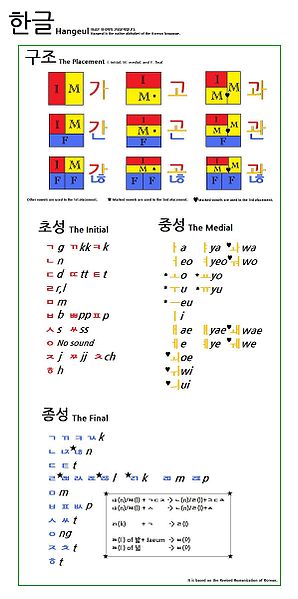hangul
This image (listed as public domain ) pretty much sums up how to read Korean. Click on it for the full-sized version.
Hangul is composed of 24 letters.
- 14 consonants: ㄱ, ㄴ, ㄷ, ㄹ, ㅁ, ㅂ, ㅅ, ㅇ, ㅈ, ㅊ, ㅋ, ㅌ, ㅍ, ㅎ
- 10 vowels: ㅏ, ㅑ, ㅓ, ㅕ, ㅗ, ㅛ, ㅜ, ㅠ, ㅡ, ㅣ
Hangul is written in blocks, where each block essentially represents a single syllable. Within each syllable, the initial and final letters will always be consonants and the medial letters will always be vowels.
| Initial+Medial |
|
The simplest Korean syllables will contain an initial consonant plus a medial vowel. In this case, the vowels ㅏ, ㅑ, ㅓ, ㅕ, and ㅣ will always be written to the right of the consonant, and the vowels ㅗ, ㅛ, ㅜ, ㅠ, and ㅡ will always be written below the consonant. Examples: 마 = ma (sounds like "mama"); 무 = mu (as in cows go "moo") |
| Initial+Medial+Final |
|
Keep the Initial+Medial rules in mind. When adding a final consonant to an initial plus medial, the final simply goes at the bottom. Examples: 만 = man; 문 = mun (sounds more like "moon") |
Combination Vowels |
| Vowels maybe combined for sounds other than the base 10. In general, reading left to right will get you relatively close to the correct pronunciation. For example, "ㅘ" is a combination of "ㅗ" (sounds like "oh") + "ㅏ" (sounds like "ah"). If you say "oh" + "ah" really quickly, it sounds like "wa". However, I am not sure how to explain the "ㅐ". For that one, I just need to remember that it sounds like "ae". | What about 한글? |
| So, why isn't 한글 written as "hangeul"? You got me there. It has to do with how Korean is romanized. Before I was introduced to the Revised Romanization of Korean, I spelled it out as it best sounded to me. I can only assume that the "Hangul" romanizataion of the word became fairly standard before the Revised Romanization took root. In any case, both "Hangul" and "Hangeul" seem to be understood. |
If you feel up to it, try testing your knowledge by taking a quiz.
